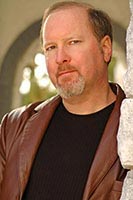interview by Carl Slaughter
 Kevin Anderson is the author of numerous Star Wars novels. He is also the coauthor, with Brian Herbert, Frank Herbert’s son, of 12 Dune novels. He most popular original series is Saga of Seven Suns. His novel Assemblers of Infinity, which was serialized in Analog, was nominated for a Nebula award. 51 of his books have been international or national best sellers, 40 of them on the New York Times bestseller list. He has had 23 million books published in 30 languages. His most recent novels are Enemies and Aliens, about the first meeting of Superman and Batman, and The Last Days of Krypton, a Superman prequel. He is a Writers of the Future judge and participates in Mike Resnick’s anthology mentor series, Stellar Guild. He is working on Saga of Shadows, a prequel trilogy. He is married to author Rebecca Moesta, with whom he has coauthored a horror comedy series. Carl Slaughter interviews Anderson for Diabolical Plots.
Kevin Anderson is the author of numerous Star Wars novels. He is also the coauthor, with Brian Herbert, Frank Herbert’s son, of 12 Dune novels. He most popular original series is Saga of Seven Suns. His novel Assemblers of Infinity, which was serialized in Analog, was nominated for a Nebula award. 51 of his books have been international or national best sellers, 40 of them on the New York Times bestseller list. He has had 23 million books published in 30 languages. His most recent novels are Enemies and Aliens, about the first meeting of Superman and Batman, and The Last Days of Krypton, a Superman prequel. He is a Writers of the Future judge and participates in Mike Resnick’s anthology mentor series, Stellar Guild. He is working on Saga of Shadows, a prequel trilogy. He is married to author Rebecca Moesta, with whom he has coauthored a horror comedy series. Carl Slaughter interviews Anderson for Diabolical Plots.
Check out Kevin’s websites at:
http://www.wordfire.com/books/
http://kjablog.com/
CARL SLAUGHTER: Why is it significant that Batman and Superman meet? Does Batman need Superman? Does Superman need Batman? Why the mid 50s? Why Lex Luthor but not the Joker?
KEVIN ANDERSON: Not only are they both icons, but they are two sides of the same coin, both “heroes” but with very different approaches. By playing one against the other, I could explore the differences more clearly. Each is convinced in his own methods, but I loved playing them against each other. I wanted to do the first meeting of Batman and Superman. If I set it in the modern period, I couldn’t figure out how to make it seem believable. But in the 1950s, that gave me a whole new playground to run around in. That was a time for Lex Luthor to shine, like a mix between a super-villain and Mad Men. Honestly, I don’t think I ever considered using the Joker; he seemed too out of control!
CS: Why delve into events on Krypton? Don’t we already know what happens? Hasn’t it already been discussed in the comic books and movies? Krypton is about to explode, so Jorel’s father sends him away from Krypton to save him and to Earth to help us. Or is it more complicated than that?
KA: I made my mark on the genre by writing big SF epics. I wanted to treat the grand planet of Krypton as the basis of a great epic, like the Last Days of Pompeii. I would argue that we know almost *nothing* about what happens on Krypton. Why does the planet explode? Why does such an advanced planet have only one spaceship? And why is it only “baby sized”? What about the Phantom Zone? The rise of General Zod, how Argo City survives under its dome, how Brainiac steals the city of Kandor? All of these hints are given, but the whole story was never pieced together. THE LAST DAYS OF KRYPTON tells the whole sweeping story,
CS: “Horror humor” sounds like a contradiction of terms. How can scary be funny and how can funny be scary? Does “horror humor” mean the story is laced with funny one liners, like a slasher saying to his victims after he cuts them up, “May you rest in pieces”? Or are the horror DNA and the humor DNA fused? Give us an example.
KA: Horror and humor have been used together very successfully for a long time. Look at Buffy the Vampire Slayer, Army of Darkness†�and more recently, Shaun of the Dead, True Blood/Sookie Stackhouse. My Dan Shamble, Zombie PI stories are more like corny spoofs, Mad Monster Party, Abbott & Costello Meet Frankenstein, but I fell in love with the characters so much when I was writing them, I would love to keep working on the series.
CS: How does an aspiring writer get into franchise writing? For screen, print, and comics. Do you have to submit outlines to a managing editor who zealously guards the franchise’s reputation? Are the tie in/spin off plots and characters allowed to differ significantly from the original canon?
KA: The problem with giving advice is that the publishing world has changed so dramatically, my experiences are no longer relevant. Most important, I didn’t “break” into the field,I was asked. Lucasfilm approached me because they had read my work; it wasn’t something I had planned ahead of time. And on the basis of my Star Wars successes, I got offered many other jobs. I don’t know how somebody can do it on purpose.
CS: Your career has been heavy on novels and heavy on series. Why not short fiction, why not original fiction?
KA: I’ve published over a hundred short stories, but my heart is really in the novels. That’s the canvas my imagination likes to paint on. When I come up with a great idea, do all the huge world building, the stories keep suggesting themselves. I like to stay with characters I have created, in universes I have built. The vast majority of my published work has been original fiction†�or do you mean “standalone novels” by your question? If I come up with a story and characters, I usually can’t limit it to a single novel.
CS: True or false: A hard science story stands a better chance of getting selected by Writers of the Future?
KA: False.
CS: You’ve had 40 books on the New York Times bestsellers list. Did this record start before or after the first million words a writer allegedly types before achieving publishable quality?
KA: I’ve had 51 national or international bestsellers; twenty or so have been on the New York Times. My first bestseller, JEDI SEARCH, was my seventh or eighth published novel, each one 100,000 words or more†�so I wasn’t quite at the million-word mark, but close. I was still practicing.
CS: What are the biggest mistakes aspiring writers make and what are the most important things aspiring writers should do?
KA: They think their writing is perfect and don’t listen to advice. If your book has been rejected 20 times, maybe there’s something wrong with it, rather than “publishers don’t understand my genius.” Also, don’t keep writing and rewriting and rewriting your first novel. Write the next one. Then the next. Then the next. That’s how you learn the most. Put in those million practice words!
CS: What’s the motivation for such a busy author to work with an unestablished writer for comparatively little pay? Is the purpose of the project to help them improve their writing or to help get their name out there? What’s the mentoring arrangement. Do they write a story and you help them revise it or do you write it together and share a byline?
KA: For “TAU CETI”, when I was approached to launch the Stellar Guild, I had an idea for a story that had fascinated me for a long time, but I knew it was only a novella length, not something I could expand into a full novel. And novellas are notoriously difficult to publish, so most of us just veto them in our creative brain. So it seemed like a great opportunity for me to write the story I wanted to do, and also give an opportunity for one of my friends and writing students, Steve Savile. (Of course, Steve wasn’t entirely a newbie, since he had been quite successful on his own.) I wrote my novella and gave it to Steve as I drafted it so he could start thinking of a related follow-up story. In fact, since Steve has been fascinated with how i write with a digital recorder, I sent Steve my raw audio files as I dictated him, so he could really see the rough versions!
 Carl Slaughter is a man of the world. For the last decade, he has traveled the globe as an ESL teacher in 17 countries on 3 continents, collecting souvenir paintings from China, Korea, Thailand, Vietnam, and Egypt, as well as dresses from Egypt, and masks from Kenya, along the way. He spends a ridiculous amount of time and an alarming amount of money in bookstores. He has a large ESL book review website, an exhaustive FAQ about teaching English in China, and a collection of 75 English language newspapers from 15 countries.
Carl Slaughter is a man of the world. For the last decade, he has traveled the globe as an ESL teacher in 17 countries on 3 continents, collecting souvenir paintings from China, Korea, Thailand, Vietnam, and Egypt, as well as dresses from Egypt, and masks from Kenya, along the way. He spends a ridiculous amount of time and an alarming amount of money in bookstores. He has a large ESL book review website, an exhaustive FAQ about teaching English in China, and a collection of 75 English language newspapers from 15 countries.
His training is in journalism, and he has an essay on culture printed in the Korea Times and Beijing Review. He has two science fiction novels in the works and is deep into research for an environmental short story project.
Carl currently teaches in China where electricity is an inconsistent commodity.

 From top to bottom, Batman: Arkham Asylum for the Sony PS3 is a vivid, detailed, and sometimes chilling foray into the gothic world of Batman.
From top to bottom, Batman: Arkham Asylum for the Sony PS3 is a vivid, detailed, and sometimes chilling foray into the gothic world of Batman. Melissa Shaw’s short fiction has appeared in
Melissa Shaw’s short fiction has appeared in